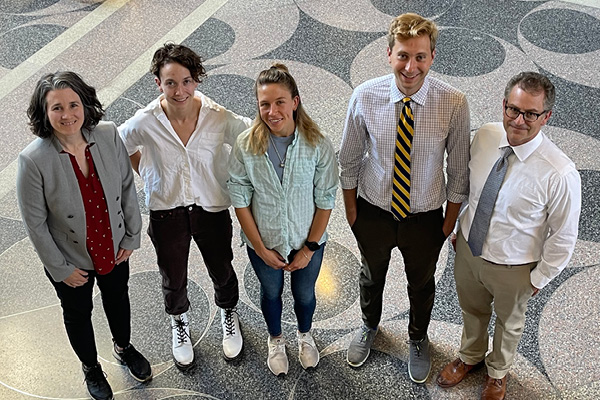
The olfactory epithelium, which is the tissue in our nasal cavity responsible for our sense of smell, has the remarkable ability to regenerate its neurons from local stem cells. This tissue is also prone to a rare type of cancer known as olfactory neuroblastoma (ONB), whose origins and growth are not well understood. Patients with ONB require highly specialized care and are treated by surgeons at the Duke Skull Base Center along with oncologists at the DCI.
To tackle this problem, a new collaboration proved helpful, between a surgeon-scientist studying olfaction (Brad Goldstein, MD, PhD) and a cancer biologist (Trudy Oliver, PhD).
Goldstein’s lab team in the Department of Head and Neck Surgery & Communication Sciences at Duke University holds expertise on the stem cells in the olfactory epithelium, while Trudy Oliver, PhD, in the Department of Pharmacology and Cancer Biology holds expertise on cancer models. When a graduate student in the Goldstein lab, Jack Finlay, decided to focus on olfactory tumors, his interest spurred the new collaboration. The team has published a new paper in the journal Cancer Cell “Olfactory neuroblastoma mimics molecular heterogeneity and lineage trajectories of small cell lung cancer” in which they share how they used genetic engineering to create a mouse model that closely resembles aggressive forms of ONB. Other collaborators from the Duke Skull Base Center, which treats patients with sinonasal cancers including ONB, are Dr. David Jang and Dr. Ralph Abi Hachem. Finlay is an MD/PhD student in the Duke Medical Scientist Training Program (MSTP) who worked closely with PhD student Abbie Ireland and technician Bryony Hawgood in Pharmacology and Cancer Biology.

Using these new models, as well as human patient samples, the team found that a particular type of olfactory stem cell called globose basal cells (GBCs) can give rise to ONB. Several other key findings emerged. For instance, olfactory tumors in mice and humans contain a variety of cell types that reflect the different stages of normal GBC development, and the new models provided a means to identify processes in which tumor cells can form different identities, both neuron-like and non-neuronal. This process, termed tumor plasticity, has important implications for understanding treatment, or treatment resistance, in other cancers. Abbie Ireland spearheaded sophisticated lineage-barcoding techniques to enable these findings.
Using the new mouse models to begin to define how tumor growth is regulated, the researchers removed a gene called Ascl1 in the tumors and found how the cancer cell growth changed. In these experiments, the tumors harbored many cells with a less differentiated identity, some resembling a tuft-like cell that resides in the olfactory epithelium and is similar to cells in the lower airway, including the lung.
Indeed, a major finding from this work is a previously unrecognized similarity between ONB and another type of cancer called small cell lung cancer (SCLC). Both mouse and human ONBs share features with SCLC, including a mix of neuronal-like and non-neuronal cell types expressing the same key regulatory genes, and a limited immune system activity within the tumor.
Overall, these findings reveal important similarities between ONB and other neuroendocrine tumors such as SCLC, which could have major implications for how researchers classify and treat olfactory neuroblastoma. For instance, ONB may share therapeutic targets with these cancers, which could be considered as new trials designed to target SCLC or other neuroendocrine tumors are deployed.
The Goldstein and Oliver labs are supported by funding from the NIH.